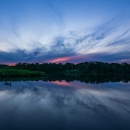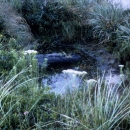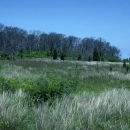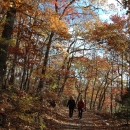About Us
Established in 1954, the Elizabeth A. Morton National Wildlife Refuge protects a 187-acre peninsula on Noyack and Little Peconic Bays. Exceptionally diverse habitats include sandy and rocky beaches that fringe the peninsula, while wooded bluffs overlook the Bays. Morton consists of upland forest, fields, ponds, salt marsh salt marsh
Salt marshes are found in tidal areas near the coast, where freshwater mixes with saltwater.
Learn more about salt marsh , beach and a lagoon. These habitats are used by a variety of wildlife including white-tailed deer, eastern chipmunk, painted turtles, green frogs, songbirds and osprey. Waterfowl, such as long-tailed duck, common goldeneye and white-winged scoter, are common during the winter months, while piping plover, terns, and other water birds use the beach during the spring and summer months.
Jessup's Neck
A major portion of the beach habitat of the refuge is known by the local residents as Jessup’s Neck. It separates Little Peconic Bay from Noyack Bay. The north-south axis of the peninsula between Long Island’s two forks also makes the refuge an important migration corridor for a variety of birds. The peninsula consists of three miles of undeveloped shoreline; one of the few shorelines without armoring or development that remain in the area. The tip of the Neck has steep, heavily eroded bluffs approaching 50 feet. Its habitats are varied and include sandy and rocky beaches; salt and freshwater marshes; brackish and freshwater ponds; lagoons; tidal flats; old fields; and oak and cedar forests.
Our Mission
Vision
Long Island National Wildlife Refuge Complex will preserve, manage, and restore some of the last significant natural areas for wildlife habitat, ranging from coastal systems, to native grasslands to mature forests. These habitats, present in nine distinct units, will support threatened and endangered species in addition to hundreds of species of migratory birds and other wildlife within the Atlantic Flyway.
Located adjacent to the nation’s major media center, the Complex is an ideal setting to increase public awareness, understanding and support of the National Wildlife Refuge System. We recognize that success is dependent on the Complex becoming an integral part of the community. We will work together with partners and local communities to protect priority wildlife-dependent recreational and educational opportunities. Through the use of the best scientific information and active habitat management, we will contribute to the fulfilling of the mission of the National Wildlife Refuge System for future generations.
Refuge Purpose
Each unit of the National Wildlife Refuge System is established to serve a statutory purpose that targets the conservation of native species dependent on its lands and waters. All activities on those acres are reviewed for compatibility with this statutory purpose.
The purpose of the Elizabeth A. Morton National Wildlife Refuge is as follows:
- “…for use as an inviolate sanctuary, or for any other management purpose, for migratory birds” (16 U.S.C. §715d).
Our History
Elizabeth A. Morton National Wildlife Refuge was the first refuge in the country named after a woman and what an amazing woman she was! Although her family originally acquired the property in 1887, Elizabeth “Betty” Alexandra Morton grew up and spent her life in Southampton. Ultimately, Elizabeth donated these 187 acres to the U.S. Fish & Wildlife Service and stayed active in refuge management decisions up until her death in 1964.
Originally three small, conical islands, Jessup’s Neck peninsula was connected over thousands of years by wind, tide, and littoral currents. The Montauk and Shinnecock native tribes inhabited the land before it was colonized in 1640 by John Farrington and John Jessup. The land was deeded to John Jessup in 1669 and henceforth called Jessup’s Neck.
Other Facilities in this Complex
The Long Island National Wildlife Refuge Complex consists of seven national wildlife refuges, two refuge sub-units and one wildlife management area wildlife management area
For practical purposes, a wildlife management area is synonymous with a national wildlife refuge or a game preserve. There are nine wildlife management areas and one game preserve in the National Wildlife Refuge System.
Learn more about wildlife management area . Collectively, the ten units are approximately 6,500 acres in size. Each unit is unique and provides a wildlife oasis amongst Long Island’s urban settings essential for the livelihood of migratory birds, threatened and endangered species, fish and other wildlife. The strategic location of Long Island in the Long Island Pine Barrens & along the Atlantic Flyway make it an important nesting, wintering and migratory stop over area for hundreds of species of birds.







